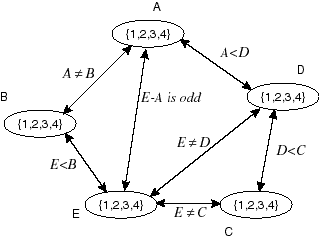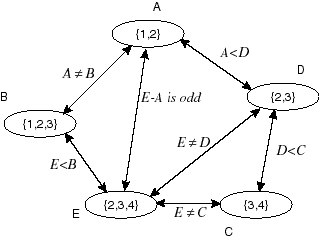There are 232 leaves. The tree can be generated by the following Prolog program.
Look at the variables. A reasonable strategy is a greedy (hillclimbing) strategy to select the variable that cuts the space most at any stage (I.e., you want to fail as quickly as possible). For example, a good ordering is A, D, C, E, B, which results in 56 leaves (see the tree).
- draw the constraint graph.

Constraint Graph - show which elements of a domain are deleted at each step, and
which arc is responsible for removing the element,
Element Removed Arc E=1 <E,B > B=4 <B,E > D=4 <D,C > C=1 <C,D > A=3,A=4 <A,D > D=1 <D,A > C=2 <C,D > - show explicitly the constraint graph after arc consistency has
stopped.

Arc Consistent Constraint Net - show how splitting domains can be used to solve this
problem. Assume we split the alphabetically first variable that has
more than one element in its domain for any arc-consistent network.
Include all arc consistency steps.
Here is the results without the arc consisteny steps:
A=1 B=2 solution (A=1, B=2, C=3, D=2, E=4} B=3 solution (A=1, B=3, C=3, D=2, E=4} A=2 failure